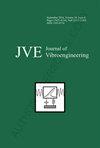爆破振动作用下高薄岩质边坡的动力响应研究
IF 0.9
Q4 ENGINEERING, MECHANICAL
引用次数: 0
摘要
双面薄岩质边坡的地形与常规研究的单面岩质边坡有很大的不同,这给研究双面薄岩质边坡的动力响应带来了困难。通过实例分析,对爆破振动作用下高薄岩质边坡的动力响应进行了具体展望。选取赤湾山高薄岩质边坡作为典型案例边坡。利用振动监测系统对箱体边坡爆破振动进行了现场监测。然后对记录的爆破振动的振幅、频率和能量特征进行了具体识别和检验。利用监测结果验证了建立的动力有限元模型,探讨了爆破振动频率和振幅对边坡动力响应的影响。利用LS-DYNA软件建立了爆破振动作用下箱体边坡的动力有限元模型。根据监测结果和数值计算结果,探讨了爆破振动作用下高薄岩质边坡的动力响应机制。结果表明:在某一高程范围内,爆破振动在南坡存在高程放大效应,主导频率随距离爆破源的远近而衰减,但在一定高程范围内基本保持不变;爆破振动频率对边坡上颗粒速度峰值的取值和分布都有较大影响,而爆破振动幅值仅对颗粒速度峰值的取值有影响。爆破振动作用下箱体边坡的动力响应是爆破地震波传播和结构共振共同作用的结果。研究结果可为清晰认识爆破振动作用下类似高薄岩质边坡的动力响应提供有效途径。本文章由计算机程序翻译,如有差异,请以英文原文为准。
Dynamic response of high and thin rock slope under blasting vibration: a case study
The topography of a thin double-sided rock slope differs greatly from that of a regularly studied single-sided rock slope, which leads to difficulties in investigating the dynamic response of the thin double-sided rock slope. Through a case study, this paper provides a specific prospect on the dynamic response of the high and thin rock slope under blasting vibration. The high and thin rock slope belonging to Chiwan Mountain was selected as the typical case slope. Field monitoring programs for blasting vibration on the case slope were carried out using vibration monitoring systems. The amplitude, frequency, and energy characteristics of the recorded blasting vibration were then concretely identified and examined. The monitoring results were further used to validate the dynamic finite element model developed to explore the effects of blasting vibration frequency and amplitude on the dynamic response of the slope. The dynamic finite element model of the case slope subjected to blasting vibration was established using the software LS-DYNA. According to the monitoring and numerical results, the dynamic response mechanism of the high and thin rock slope under blasting vibration was discussed. The results indicate that the elevation amplification effect of blasting vibration exists on the southern slope from a certain elevation, and the dominant frequencies generally decay with the distance from the blasting source but remain largely the same within a specific elevation range. The blasting vibration frequencies have considerable influence on both the values and distributions of peak particle velocities on the slope while the blasting vibration amplitudes have an impact only on the values of peak particle velocities. The dynamic response of the case slope under blasting vibration results from the joint effects of blasting seismic wave propagation and structural resonance. The research findings may pave an effective way to clearly understand the dynamic response of similar high and thin rock slopes under blasting vibration.
求助全文
通过发布文献求助,成功后即可免费获取论文全文。
去求助
来源期刊

Journal of Vibroengineering
工程技术-工程:机械
CiteScore
1.70
自引率
0.00%
发文量
97
审稿时长
4.5 months
期刊介绍:
Journal of VIBROENGINEERING (JVE) ISSN 1392-8716 is a prestigious peer reviewed International Journal specializing in theoretical and practical aspects of Vibration Engineering. It is indexed in ESCI and other major databases. Published every 1.5 months (8 times yearly), the journal attracts attention from the International Engineering Community.
 求助内容:
求助内容: 应助结果提醒方式:
应助结果提醒方式:


